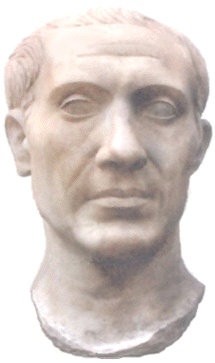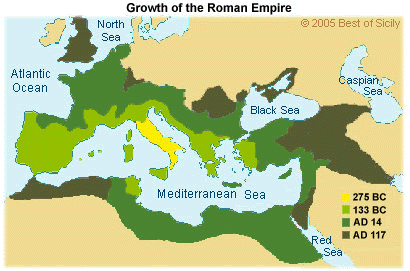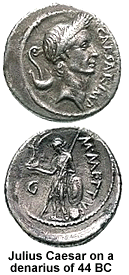...Best of Sicily presents... Best of Sicily Magazine. ... Dedicated to Sicilian art, culture, history, people, places and all things Sicilian. |
by Vincenzo Salerno | |||||
Magazine Index Best of Sicily Arts & Culture Fashion Food & Wine History & Society About Us Travel Faqs Contact Map of Sicily
|
Language, the calendar, the alphabet, art, architecture, literature, forms of government, legal systems and even our eating utensils were influenced by Roman civilization. Despite medieval (post-Roman) influences, the rudimentary blueprint for what we now call "Western Civilization" was the society of the ancient Romans. While it presents a balanced view and takes into account the fundamental equality of diverse peoples, today's multicultural perspective of world history often overlooks the pre-eminent importance of Rome's defining role in the history of humanity. During the Renaissance, Italy breathed new life into the classical Roman tradition. Through colonial expansion, the British, French, Spanish, Portuguese and Dutch brought Western European culture and traditions around the world. The results were not always positive but they could rarely be ignored. Influenced by the Etruscans of central Italy and the Greeks of the south,
Roman society evolved from a tribal Italic culture (akin to those of the
Ligurians and Lucanians) to become one of the most sophisticated societies
of all time. European culture was --and is-- defined by its Roman heritage.
It is the single historical influence that all Europeans share, even if
(as in the case of Scandinavians and Slavs) indirectly. Constantinople (capital
of the Eastern Roman Empire) considered herself the second or "new"
Rome and Moscow claimed to be the third. In the early Christian Church,
the Patriarch of Rome was "primus inter pares" (first among equals)
among patriarchs. The medieval rulers of a realm extending from Saxony to
Sicily were "Holy Roman Emperors" crowned by the Pope of Rome
even if, as has been observed, their domain The Romanesque and Neo Classical styles preserved Roman architectural traditions long after the fall of Rome. The English language (now the world's most widely spoken tongue) is peppered with Latin legal phrases and numerous words bearing Latin roots, and the page you're reading is written using the Roman alphabet. Every day, speakers of Spanish, French, Italian, Portuguese, Romanian, and even English and German, use words which would be perfectly recognizable to the ears of Julius Caesar, though he would be surprised to witness the enduring influence of his Empire's culture. The annals of history themself were defined by Romans, with years based on the birth of Jesus in the Roman province of Judea. Rarely (with the possible exception of today's Americans) has a single --and singular-- people ever influenced the lives of so many others. Without doubt the Romans were a singular people, at once unspeakably cruel and compassionately democratic. Barbaric and intolerant yet creative and intellectual. The epitome of contradiction. Willing to embrace foreign cultures but underestimated only at their adversaries' mortal peril. Sicily became the first Roman province in 227 BC (BCE), although it remained
essentially Greek for centuries. True, the Romans Latinized Sicilian society,
though perhaps not as much as is often believed. However, the accomodation
of local cultures was a key factor in preserving the vast Roman Empire for
a thousand years, and this experiment was first attempted (with success)
in Sicily. In many ways, Greek civilization represented the Romans' mother
culture. Though Latin was introduced, Greek (the "intellectual"
language of upper-class Romans) continued to be widely To understand the Romans' role in Sicily and elsewhere, it is necessary to understand Rome, the people of Rome and the Roman world. (This very concise survey concentrates on Roman Sicily without seeking to present a detailed history of the Roman Empire, which would require volumes.) Ancient Rome emerged around 700 BC on seven wooded hills along the River Tiber in Latium in south-central Italy. The earliest Romans, Latins present in settlements such as the Palatine Hill from about 1000 BC, were greatly influenced by the more advanced Etruscans, who ruled the territories to the north and east of Rome, with a capital at Felsina (now Bologna). Little is known of the origins of the Etruscans, whose language, though probably not Indo-European, made use of an alphabet influenced by Phoenician and Greek. Present in Italy from at least 800 BC, the Etruscans knew of the cultures to the south, including those of the Greeks (Magna Graecia) and Carthaginians. By 275 BC, the Romans had assimilated with the Etruscans, as well as various Italic peoples, and controlled the Italian peninsula. This became the "home" province of Rome, and by AD (CE) 117 as many as six million people lived there, with at least ten times that many in the entire Empire. In time, most were granted Roman citizenship, and among Rome's emperors were citizens born in various parts of the Empire; in this respect overt ethnic bigotry was not a serious social problem in Roman society, though religious and cultural differences certainly existed among its diverse peoples. The Romans frequently left local rulers in nominal control of conquered lands. Despite uniform standards of law and even architecture, the far-flung provinces of the Empire often enjoyed localized (ethnic) social practices such as the continued practice of local religions. By 300 BC, as Rome enjoyed ever more contact with Greece, particularly through the Sicilians, Roman society began to imitate Greek society in many ways. Romans worshipped the Greek gods, albeit under different names and with less devotion than the Greeks, and imitated Greek architecture and urban planning. Greek literature and science greatly influenced Roman ideas. The Romans built upon what they learned from the Greeks and others. (Christianity began to make serious inroads into Roman society by AD 100, though it was still outlawed at that time.) Roman engineering was sophisticated, but the Romans are credited with few insights into pure science and mathematics. Life in the cities didn't change very much, but Roman agricultural policy differed somewhat from that of the Greeks. Under the Romans, Sicily's forests gave way to the first large grain farms. As a source of hard wheat, Sicily became the "granary of the Roman Empire." The Empire grew and Sicily, near its geographical center, became a crossroads of the Mediterranean; Saint Paul preached in Syracuse on his way to Rome. Never in its long history has Sicily known peace for as long as it did during the Roman period. This followed the second and third Punic Wars against the Carthaginians, with the virtual destruction of the north-African city in 146 BC. Administration was generally efficient and problems few. The Syrian slave Eunus led a celebrated revolt suppressed in 131 BC, and another slave revolt --by Trifon-- was suppressed in 99 BC. These revolts lasted for years. In 70 BC, the praetor Verres was accused of fraud by several Sicilian towns but decided to flee when he learned that their legal case was to be argued by Cicero, the greatest orator of his time. When Tauromenion (Taormina) sided with Pompey against Augustus (Octavian), the latter retaliated by seizing the town for his soldiers. In general, the influx of Romans into Sicily was more peaceful. The Roman villa near Piazza Armerina, built around AD 300, is an exceptional example of aristocratic architecture, but its splendor probably was not unique in its time. Owing partly to its earlier existence as a highly-advanced Greek region, Sicily required little additional architectural "development" by the Romans. Yet cities which were quite unimportant under the Greeks grew considerably under the Romans. Panormus (Palermo) comes to mind; the large Roman city was built upon a Punic-era settlement. The Roman theatres in Catania are still largely in tact. It was during the Roman era that the foundation of a Sicilian vernacular language was established. Initially, this was a blend of Latin and Greek, both widely spoken throughout Sicily's Roman era. Sicilian is a Latin (Romance) language, but by the end of the Middle Ages it had many French, Germanic and Arabic characteristics. Except for some initial revolts in Syracuse during the Punic Wars, the Sicilians did not actively resist the Roman annexation. The island's population grew under the Romans, but it is difficult to ascertain the number that immigrated. There was not a mass colonization, but rather pockets of immigration activity over the centuries. Syracuse remained the most important city, and perhaps the most populated, but it was not always the capital. Established in 509 BC, the Roman Republic shed the leadership of Etruscan
kings in favor of a more democratic system of government. In time, this
was modified and corrupted, but its fundamental structure remained in place
for centuries. Roman society was structured fairly rigidly, with patricians
at the top and plebians, the majority of the populace, beneath them. By
287 BC, the plebians had achieved rights almost equal to those of the patricians.
Slaves, a kind of underclass, could gain Rome defeated Carthage and began a rapid expansion both eastward and westward. Julius Caesar brought Gaul (France), Iberia (Spain) and Egypt under Roman influence. Eventually, these became part of the Empire. Caesar's growing power brought about his assassination. In 27 BC, following a civil war against Mark Antony, Caesar's nephew, Octavian, became emperor as Augustus Caesar, though he preferred the title of "princeps" (first citizen). The Pax Romana (Roman Peace) begun under Augustus lasted two centuries, with the addition of various territories, such as Britain in AD 43 and Dacia (now Romania and part of Hungary) in AD 106. At its greatest extent, the Roman Empire encompassed lands from Scotland to the Persian Gulf. After AD 300, despite the efforts of enlightened emperors such as Constantine I, who relocated the capital to Byzantium in 330, the empire began to disintegrate, especially in its western regions. Barbarian raids and localized uprisings became more prevalent, while a stagnant, corrupt centralized government found itself ill-prepared to meet new threats. It has been suggested that excessive assimilation with "foreign" cultures, and assumption of soldiers from these societies, was a key reason for Rome's fall. While such factors cannot be ignored, the greatest shortcoming of Rome was itself. The empire destroyed itself from within. By 400, the end was near, at least in the west. The Roman Empire split in 395, with the eastern half preserving its great culture and traditions. Officially, Sicily was part of the Western Empire after AD 395, but following the fall of centralized power in Rome (the city was sacked in 410 and Odoacer formally assumed power in 476), a period of foreign rule by Vandals and Ostrogoths (from AD 468 until 535) ensued in Sicily. It was then annexed to the Byzantine Empire, a medieval state (ruled from Constantinople until 1453) which evolved from the Eastern Roman Empire. About the Author: Palermo native Vincenzo Salerno has written biographies of several famous Sicilians, including Frederick II and Giuseppe di Lampedusa. | ||||
Top of Page |
 Their heritage
is the world's. Their empire --though vast-- was only half as large as the Mongol
Empire, but more than twice as influential in shaping society on a global
scale long after its demise. It is the standard by which other societies
are measured. At its greatest extent, it encompassed Italy and every land
touching the Mediterranean (Spain, Portugal, France, Greece, Albania, Egypt,
Palestine and Israel, Syria, Lebanon, Turkey, Tunisia, Morocco, Algeria,
Libya), Austria, Armenia, most of Britain (including Wales and part of Scotland),
Belgium, Romania, Bulgaria and most of the Balkans, Mesopotamia (Iraq) and
Kuwait, small parts of Persia (Iran) and Arabia, southern Ukraine, Switzerland
and half of Germany. Its sphere of influence was far wider, extending into
Germany, Denmark, Poland, Sudan and Ethiopia.
Their heritage
is the world's. Their empire --though vast-- was only half as large as the Mongol
Empire, but more than twice as influential in shaping society on a global
scale long after its demise. It is the standard by which other societies
are measured. At its greatest extent, it encompassed Italy and every land
touching the Mediterranean (Spain, Portugal, France, Greece, Albania, Egypt,
Palestine and Israel, Syria, Lebanon, Turkey, Tunisia, Morocco, Algeria,
Libya), Austria, Armenia, most of Britain (including Wales and part of Scotland),
Belgium, Romania, Bulgaria and most of the Balkans, Mesopotamia (Iraq) and
Kuwait, small parts of Persia (Iran) and Arabia, southern Ukraine, Switzerland
and half of Germany. Its sphere of influence was far wider, extending into
Germany, Denmark, Poland, Sudan and Ethiopia. was not holy, Roman or even an empire. In the United States,
modern structures built in imitation of ancient Roman ones house legislative
bodies whose elective representatives are called "senators."
was not holy, Roman or even an empire. In the United States,
modern structures built in imitation of ancient Roman ones house legislative
bodies whose elective representatives are called "senators." spoken throughout the Roman rule of Sicily and the regions to
the east. In most cases, bilingual societies emerged, with Latin used by
the invading Romans and in official inscriptions but the local vernacular
being preserved in everyday speech, though perhaps influenced by Latin.
Initially, Latin seems to have had a more general influence in western regions
where there was previously no widely-used written language or where there
was high illiteracy. In its final centuries the Roman Empire, divided into
East and West, continued in Byzantium (Constantinople) long after these
western regions had fallen to invaders.
spoken throughout the Roman rule of Sicily and the regions to
the east. In most cases, bilingual societies emerged, with Latin used by
the invading Romans and in official inscriptions but the local vernacular
being preserved in everyday speech, though perhaps influenced by Latin.
Initially, Latin seems to have had a more general influence in western regions
where there was previously no widely-used written language or where there
was high illiteracy. In its final centuries the Roman Empire, divided into
East and West, continued in Byzantium (Constantinople) long after these
western regions had fallen to invaders. citizenship --and freedom-- under
certain conditions. In 27 BC, following two decades of civil war, the Empire
succeeded the Republic. This led to less actual democracy for many, but
the Empire was generally prosperous for several centuries to follow, supported
by an extensive network of conquered lands.
citizenship --and freedom-- under
certain conditions. In 27 BC, following two decades of civil war, the Empire
succeeded the Republic. This led to less actual democracy for many, but
the Empire was generally prosperous for several centuries to follow, supported
by an extensive network of conquered lands.